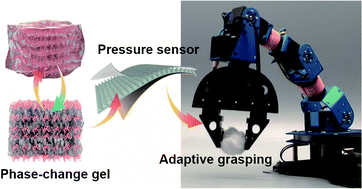A phase-change gel based pressure sensor with tunable sensitivity for artificial tactile feedback systems†
Abstract
The somatosensory system in the skin plays an essential role for human hands to perform adaptive interactions with external environments, such as tactile sensing and handling objects. For artificial pressure sensors, the realization of high sensitivity and a broad sensing range to emulate biological tactile receptors is desirable but challenging. Herein, we report a novel strategy to design a phase-change-gel (PC-gel)-based pressure sensor with tunable sensitivity and sensing ranges. By tuning the Young's modulus of the PC-gel through a phase change, the pressure sensor can switch between a high sensitivity mode with a low limit of detection (2 Pa) and a low sensitivity mode with a broad sensing range (up to 350 kPa). By integrating a PC-gel-based sensor on a robotic gripper, we fabricated an artificial tactile feedback system to emulate object handling. Based on real-time monitoring of the tactile signal, the system autonomously adjusted the grasping force to adapt to various objects with different stiffness. This work provides a new strategy for designing functional pressure sensors, and paves the way for intelligent robotic technologies, including adaptive grasping, biomimetic robots, and human–machine interactions.

- This article is part of the themed collection: Journal of Materials Chemistry A Emerging Investigators


 Please wait while we load your content...
Please wait while we load your content...